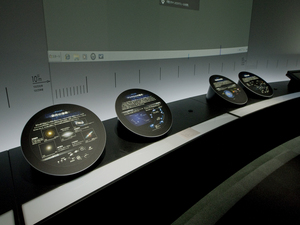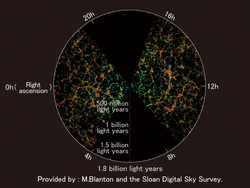Nagoya City Science Museum
TOP > Exhibition Guide > Floor Map> Galaxies
Galaxies

Purpose of Exhibition
Come into this gallery from the north entrance and walk clockwise around the perimeter, looking at the displays, you will travel from our earth to the end of the Universe. The outer ring is lined with various astronomical objects and cosmic events in order. This exhibit is based on the idea of Powers of Ten, where the scale increases tenfold each time.
You have traveled from the earth to the solar system, from the solar system to the star world, and now you are entering the world of galaxies. This exhibit will show you the Milky Way Galaxy and other galaxies on large screens in particular, and display types of galaxies, rotation of spiral galaxies, active galactic nuclei, the Andromeda galaxy, the Local Group of Galaxies, groups of galaxies and clusters of galaxies.


Additional Knowledge
[What Is the Hierarchical Structure of the Universe?]
The solar system consists of the sun and eight planets including the earth, asteroids, comets and trans-Neptunian objects, all of which are bound by gravity and, aside from the sun itself, orbit around it.
Stars that shine by themselves, of which our sun is a prime example, are called fixed stars. Some of them gather in globular clusters or open clusters.
Galaxies then form from tens to hundreds of billions of stars, clusters and interstellar matters, which are gravitationally combined.
Some galaxies are alone, while others in groups.
・Group of Galaxies: a collection of several to dozens of galaxies with a diameter of about 1.5 million light years.
・Cluster of Galaxies: an aggregation of more than fifty galaxies clustered over an area of about tens of millions of light years.
・Supercluster of Galaxies: an assembly of these groups and clusters.
In a supercluster, about 10,000 galaxies are distributed like a flat wall within a few hundred million light years, and we call these gigantic structures the Great Wall.
The above implies that galaxies are not uniformly distributed throughout the Universe, but there are regions where galaxies concentrate and regions where there are almost no galaxies, namely voids. This structure is similar to bubbles of soap. Galaxies are spread out in the Great Walls, which is the surface of bubbles. The Walls surround the voids, as soap bubbles enclose air. We call this Bubbly Structure, or Large-Scale Structure of the Universe. The diameter of a bubble is a tremendous 150 to 200 million light years.
It is thought that such hierarchical structure comes from the diffusion of density inhomogeneities in the early universe.
This page was last edited on 30 June 2022.
Article by Astronomy Section
